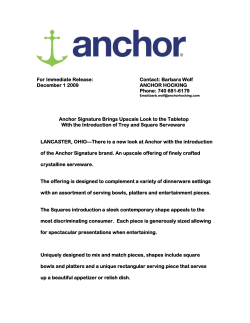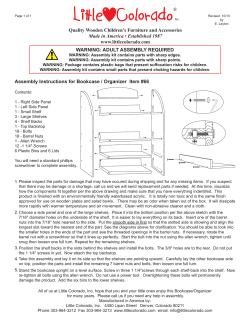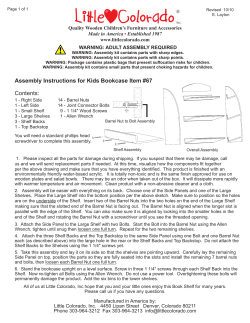
HOW TO BUILD AND INSTALL A
Water Conservation Web Resources Global Issues United Nations: http://www.unescap.org/enrd/wmrs/publications/wrs/81.htm Water Conserve Search Engine: http://www.waterconserve.info/links/ Water Conservation in the United States United States Environmental Protection Agency: http://www.epa.gov/watersense/ and http://www.epa.gov/epawaste/conserve/rrr/greenscapes/index.htm American Water Works Association: http://www.awwa.org/Resources/Waterwiser.cfm?navItemNum ber=1561 Natural Resource Conservation Service: http://www.nrcs.usda.gov/feature/backyard/watercon.html The Alliance for Water Efficiency: http://www.allianceforwaterefficiency.org/resourcelibrary/default.aspx Water Conservation in New Jersey Department of Environmental Protection: http://www.njdrought.org/ideas.html New Jersey Consumer Conservation Handbook (page 48 - 61): http://www.state.nj.us/publicadvocate/utility/docs/conservation %20handbook%204th%20Edition.pdf Water Conservation in Your Town and at Home 25 Ways to Conserve Water at Home: http://eartheasy.com/live_water_saving.htm Helpful Hints from Rutgers: http://njedl.rutgers.edu/ftp/PDFs/3127.pdf or http://water.rutgers.edu New Jersey Water Supply Authority The New Jersey Water Supply Authority (NJWSA, www.njwsa.org) was created in 1981 to operate existing water supply systems, and to develop future State water supply projects as recommended in the State Water Supply Master Plan. HOW TO BUILD AND INSTALL A RAIN BARREL The Authority’s Raritan Basin System consists of Spruce Run Reservoir, Round Valley Reservoir and the Delaware and Raritan Canal, and provides the basic source of water supply to a number of public and private water utilities serving more than 1,500,000 people in central New Jersey. The Manasquan Water Supply System in Monmouth County serves more than 250,000 people in the Monmouth County area. Under agreement with the Monmouth County Improvement Authority, the Authority also operates and maintains a four million gallon per day water treatment plant and distribution system for five municipalities in Monmouth County. NJWSA’s Watershed Protection Programs Division was formed in 1999, and served as project lead for the Raritan Basin Watershed Management Project, resulting in a comprehensive characterization and assessment report and management plan for the Raritan Basin (http://www.raritanbasin.org/technical_reports.htm and http://www.raritanbasin.org/RBWMP_CD/index.htm). NJWSA established a customer-funded Source Water Protection Fund to provide support for projects that result in the protection of drinking water sources. YOU CAN MAKE A DIFFERENCE Rain Barrels: http://www.northjersey.com/betterliving/gardening/21666859.html Rain Gardens: http://www.npsnj.org/rain_garden_home.htm Calculating Your Roof Runoff: http://www.vacd.org/winooski/winooski_raingarden_water.shtml Upper Raritan Watershed Association: http://www.urwa.org/index.html South Branch Watershed Association: http://www.sbwa.org/ Stony Brook Watershed Association: http://www.thewatershed.org/ NEW JERSEY WATER SUPPLY AUTHORITY WATERSHED PROTECTION PROGRAMS 74 East Main Street Somerville, New Jersey 08876-2312 Phone: (908) 685-0315 Fax: (908) 685-0195 Web: www.raritanbasin.org New Jersey Water Supply Authority Watershed Protection Programs Division WHEN IT RAINS IT STORES How to Build and Install a Rain Barrel What is a Rain Barrel? A rain barrel is a system that collects and stores rainwater from your roof that would otherwise be lost to runoff and diverted to storm drains and streams. Usually a rain barrel is composed of a 55 gallon drum, a vinyl hose, PVC couplings, a screen grate to keep http://www.midwestinternetsales.com/rainbarrels.htm debris and insects out, and other offthe-shelf items. A rain barrel is relatively simple and inexpensive to construct and can sit conveniently under any residential gutter down spout. What are the advantages of a rain barrel? When stormwater runs off of impervious surfaces such as roofs, parking lots, compacted soils, and roads, it accumulates sediments, nutrients like phosphorus, bacteria from animal wastes, oil, grease and heavy metals from cars, and delivers these pollutants to nearby rivers and streams. Stormwater threatens the integrity of our drinking water source, the water quality of streams that we swim in, and the habitat of fish and other aquatic life. Rain barrels are an important part of the solution, as they intercept stormwater before it runs across the landscape and into our waterways. The stormwater collected in a rain barrel can be used to water lawns and gardens, thereby conserving water and protecting water quality. Tips… • • • • Ask your home improvement store where to find the component parts of your project. Take your rain barrel “off line” in winter to avoid damage. Decorate your rain barrel to individualize your work…be creative. Involve the kids…they are eager to save the planet. (Tips from the EPA) Materials 1 - 55 gallon polyethylene plastic barrel (Plastic barrels or drums may be available for free or low cost from commercial car washes, bottling companies or other food businesses that use liquids.) 1 - 10 foot length of 2 inch PVC pipe 1 - 2 inch PVC elbow 1 - 2 inch female threaded by 2 inch PVC elbow 1 - 2 inch male threaded by 2 inch pipe adapter 1 - tube silicone sealer/cement 1 - 1/2 inch female threaded silcock (aka outdoor faucet or hose bib) 1 - 1/2 inch threaded bushing 1 - 1/2 inch female threaded socket 1 - roll teflon tape 1 - 1 foot by 2 foot piece of old or new screen fabric 1 - 1 gallon plastic bucket, tub or flowerpot 4 - cinder blocks Optional - paint to match your house color Tools Jig Saw Scissors Screw Driver Hack Saw Tape Measure Level Pipe Wrench and Pump Pliers Power Drill with 3/4 inch Spade Bit Procedure Step 1 - Inflow - Cut a hole in the top of barrel to allow rainwater to enter the barrel and to access the inside of the barrel. The hole should be just large enough to snugly fit the 1 gallon plastic bucket, tub or flowerpot. The bucket will be used to support a screen to keep mosquitoes and debris out. Cut a 3/4 inch hole in the bucket. Step 2 - Spigot - Drill a 3/4 inch hole close to bottom of the 55 gallon barrel. (Don't drill the hole too far down inside the barrel may need the help of a friend with very long arms!) Put teflon tape on the 1/2 inch bushing and thread it into the silcock or hose bib. Now carefully thread the other end of bushing into the 3/4 inch hole in bottom of barrel. It should fit snugly in the hole and cut threads in the plastic as you screw it in. Now unscrew it from the barrel, apply teflon tape to the threads of the bushing and apply silicone to the outside of the flange on the silcock. Screw it back into the hole and into a 1/2 inch socket on the inside of the barrel. Step 3 - Down Spout Modification - Prepare the area under the down spout where you want to install the rain barrel. Remove the old down spout and splash block and level the area where the barrel will sit. Place the concrete blocks so they are sloped slightly downward away from the house. Set the barrel on the blocks. With a hacksaw cut the down spout so it is just long enough to fit into the bucket on top of the rain barrel. Step 4 - Overflow - You should provide an overflow for water if the barrel fills to the top. With a jig saw, cut a hole in the side of the barrel large enough to fit the 2 inch male threaded by 2 inch pipe adapter. Place this fitting inside the barrel and thread it into the 2 inch female threaded by 2 inch PVC elbow on the outside of the barrel. Seal with silicone. Cut a length of 2 inch PVC pipe long enough to reach the ground. Attach a 2 inch PVC elbow to the bottom of this pipe and cut another length of 2 inch pipe to connect to a splash block. Where can I buy a ready-made rain barrel? Ready-made rain barrels can be purchased from a number of companies, including hardware stores and garden supply stores. In addition, local governments sometimes offer them for a reduced price as part of their environmental education programs. Below are just a few sources (this listing does not constitute an endorsement). Ace Hardware Home Depot Lowe’s Tractor Supply Co. Price range: $90 to $125 Price range: $79 to $300 Price range: $90 to $229 Price range: $110
© Copyright 2025












